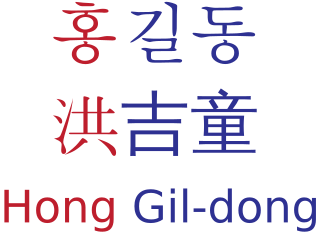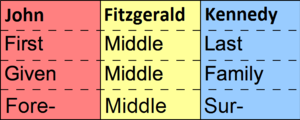Surname conventions and laws vary around the world. This article gives an overview of surnames around the world.
A patronymic, or patronym, is a component of a personal name based on the given name of one's father, grandfather, or an earlier male ancestor. It is the male equivalent of a matronymic.
A nickname or nick, also known as a sobriquet, is a substitute for the proper name of a person, place or thing. It is commonly used to express affection, amusement, a character trait or defamation of character. It is distinct from a pseudonym, stage name or title, although the concepts can overlap. Nicknames are typically informal.
Chinese surnames are used by Han Chinese and Sinicized ethnic groups in Greater China, Korea, Vietnam and among overseas Chinese communities around the world such as Singapore and Malaysia. Written Chinese names begin with surnames, unlike the Western tradition in which surnames are written last. Around 2,000 Han Chinese surnames are currently in use, but the great proportion of Han Chinese people use only a relatively small number of these surnames; 19 surnames are used by around half of the Han Chinese people, while 100 surnames are used by around 87% of the population. A report in 2019 gives the most common Chinese surnames as Wang and Li, each shared by over 100 million people in China. The remaining eight of the top ten most common Chinese surnames are Zhang, Liu, Chen, Yang, Huang, Zhao, Wu and Zhou.

A surname, family name, or last name is the mostly hereditary portion of one's personal name that indicates one's family. It is typically combined with a given name to form the full name of a person.

A courtesy name, also known as a style name, is a name bestowed upon one at adulthood in addition to one's given name. This practice is a tradition in the East Asian cultural sphere, including China, Japan, Korea, and Vietnam.

A Korean name in the modern era typically consists of a surname followed by a given name, with no middle names. A number of Korean terms for names exist. For full names, seongmyeong, seongham, or ireum (이름) are commonly used. When a Korean name is written in Hangul, there is no space between the surname and the given name.

Chinese names are personal names used by individuals from Greater China and other parts of the Sinophone world. Sometimes the same set of Chinese characters could be chosen as a Chinese name, a Hong Kong name, a Japanese name, a Korean name, a Malaysian Chinese name, or a Vietnamese name, but they would be spelled differently due to their varying historical pronunciation of Chinese characters.
Japanese names in modern times consist of a family name (surname) followed by a given name. Japanese names are usually written in kanji, where the pronunciation follows a special set of rules. Because parents when naming children, and foreigners when adopting a Japanese name, are able to choose which pronunciations they want for certain kanji, the same written form of a name may have multiple readings. In exceptional cases, this makes it impossible to determine the intended pronunciation of a name with certainty. Even so, most pronunciations chosen for names are common, making them easier to read. While any jōyō kanji and jinmeiyō kanji may be used as part of a name, names may be rejected if they are believed to fall outside what would be considered an acceptable name by measures of common sense.

A personal name, full name or prosoponym is the set of names by which an individual person is known, and that can be recited as a word-group, with the understanding that, taken together, they all relate to that one individual. In many cultures, the term is synonymous with the birth name or legal name of the individual. In linguistic classification, personal names are studied within a specific onomastic discipline, called anthroponymy.

A given name is the part of a personal name that identifies a person, potentially with a middle name as well, and differentiates that person from the other members of a group who have a common surname. The term given name refers to a name usually bestowed at or close to the time of birth, usually by the parents of the newborn. A Christian name is the first name which is given at baptism, in Christian custom.

An art name, also known by its native names hào, gō, ho, and tên hiệu, is a professional name used by East Asian artists, poets and writers. The word and the concept originated in China, where it was used as nicknames for the educated, then became popular in other East Asian countries.
A double-barrelled name is a type of compound surname, typically featuring two words, often joined by a hyphen. Notable people with double-barrelled names include Winnie Madikizela-Mandela, Sacha Baron Cohen and JuJu Smith-Schuster.
Indonesian names and naming customs reflect the multicultural and multilingual nature of the over 17,000 islands in the Indonesian archipelago. The world's fourth most populous country, Indonesia is home to more than 1300 ethnic groups, each with their own culture, custom, and language. The Javanese are the largest single group, comprising around 40 percent of Indonesia's total population.
Traditional Vietnamese personal names generally consist of three parts, used in Eastern name order.
Filipinos have various naming customs. They most commonly blend the older Spanish system and Anglo-American conventions, where there is a distinction between the "Christian name" and the "surname". The construct containing several middle names is common to all systems, but the multiple "first" names and only one middle and last name are a result of the blending of American and Spanish naming customs.
Hungarian names include surnames and given names. Some people have more than one given name, but only one is normally used. In the Hungarian language, whether written or spoken, names are invariably given in the "Eastern name order", with the family name followed by the given name. Hungarian is one of the few national languages in Europe to use the Eastern name order, like Chinese, Japanese, Korean, Vietnamese, Khmer and some Basque nationalists.
French names typically consist of one or multiple given names, and a surname. Usually one given name and the surname are used in a person's daily life, with the other given names used mainly in official documents. Middle names, in the English sense, do not exist. Initials are not used to represent second or further given names.
Indian names are based on a variety of systems and naming conventions, which vary from region to region. In Indian culture, names hold profound significance and play a crucial role in an individual's life. The importance of names is deeply rooted in the country's diverse and ancient cultural heritage. Names are also influenced by religion and caste and may come from epics. In Hindu culture, names are often chosen based on astrological and numerological principles. It is believed that a person's name can influence their destiny, and selecting the right name is essential for a prosperous and harmonious life. Astrologers may be consulted to ensure a name aligns with the individual's birth chart. India's population speaks a wide variety of languages and nearly every major religion in the world has a following in India. This variety makes for subtle, often confusing, differences in names and naming styles. Due to historical Indian cultural influences, several names across South and Southeast Asia are influenced by or adapted from Indian names or words.
Personal names in Malaysia vary greatly according to ethno-cultural group. Personal names are, to a certain degree, regulated by the national registration department, especially since the introduction of the National Registration Identity Card (NRIC).






